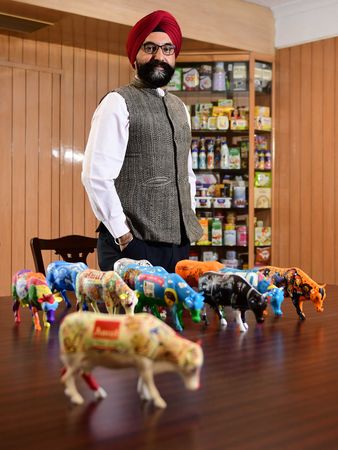WHEN A HANDFUL of farmers in two villages in Gujarat formed the Kaira District Co-operative Milk Producers' Union in 1946, it produced just about 250 litres of milk a day. It turned into a revolution under Verghese Kurien, India's milkman. Today, the Gujarat Co-operative Milk Marketing Federation (GCMMF) is spread across 18,700 villages and has 18 member unions.
GCMMF's Amul is Asia’s largest milk brand and a market leader in India of most dairy products like butter, ghee, yoghurt, butter milk, lassi and flavoured milk. But R.S. Sodhi, managing director of GCMMF, does not want Amul to rest on its laurels, and he has been charting out the milk giant's diversification plans.
Amul recently launched fruit juices under the Amul Tru brand. GCMMF is betting on Amul’s strong network and brand popularity to drive the sales. It will not be a cakewalk, though. Dabur’s Real, Coca-Cola’s Minute Maid and Pepsico’s Tropicana brands have a strong presence in the market. Startups like Hector Beverages’ Paper Boat also have made a splash. “We saw this juice-based category growing like anything,” said Sodhi. “The change we did was, we added milk solids [to juice]. Amul Tru is a differential product with juice plus milk solids.”
Amul’s foray into the fruit juices segment follows its expansion into the frozen snacks market, leveraging its existing cold chain. Last year it launched products like French fries, aloo tikki and hash browns under the Happy Treats brand. “We have got the biggest frozen foods distribution highway,” said Sodhi. “Especially, during winter when the production is less in segments like ice creams, we thought of buying potatoes from farmers and converting it into potato products.”
Of late, Amul has also been strengthening its chocolates business. Though it entered the segment in the 1970s, it started pushing products aggressively only recently, especially black chocolates. A new plant on the outskirts of Anand, inaugurated last September, can produce 1,000 tonnes of chocolate a month. Currently, chocolate business contributes just around 3 per cent of GCMMF’s turnover, but Sodhi sees it growing in the future. He claims Amul has already become the number one player in dark chocolates.
Mondelez International, maker of Cadbury Dairy Milk chocolate, controls more than 60 per cent of India's Rs 8,200 crore chocolate market, and is followed by multinationals Nestle and Ferrero. Homegrown consumer goods major ITC also has plans to get more aggressive in the chocolate market.
Despite the diversification plans, GCMMF’s focus continues to be on the dairy business. “The size of India’s organised dairy industry is Rs 1.7 lakh crore and Amul brand is only 25 per cent of that,” said Sodhi. “The organised industry is growing at a double-digit rate. So, our main focus will always be dairy.”
GCMMF will invest Rs 600 to 800 crore in new processing and packaging facilities every year. It has 69 plants and five more are in the pipeline. The member unions of Amul plan to enhance milk processing capacity from the current 350 lakh litres a day to 380-400 lakh litres in the next two years. In south India, a market that is dominated by strong regional players, GCMMF is looking to improve its distribution reach.
“Our turnover in 2009-10 was Rs 8,000 crore. It has grown to around Rs 33,000 crore in the financial year ending March 31, 2019. What we are looking at is that, in another 10 years, it will be around Rs 1 lakh crore,” said Sodhi.
GCMMF is not just tapping the Indians at home, but sees the large diaspora in markets like West Asia and North America as huge opportunities. It started local manufacturing of ghee, shrikhand and paneer in the US in a third party facility in 2014. “There are 3 million Indians in the US. To send them products from India, particularly fresh products, is difficult. So why not have a presence there? We are still in the planning stage on what to do and haven’t worked it out yet,” said Sodhi.
GCMMF had exports worth Rs 800 crore in the last financial year. Sodhi sees a big opportunity here. “Bangladesh, Sri Lanka, China and Russia, South East Asian countries and West Asia are milk deficient countries. They are importing mainly from Europe, New Zealand or Australia, while we are next door,” he said.
The competition in Amul’s own backyard, however, is intensifying. French dairy giant Groupe Lactalis made its third acquisition in India in January, buying the milk products business of Prabhat Dairy for around Rs 1,700 crore. Lactalis now has 11 factories in India and it collects 23 lakh litres of milk a day.
New Zealand’s Fonterra, which is the world’s largest dairy exporter, has inked a joint venture with Kishore Biyani’s Future Consumer to produce a range of dairy products. The first batch will be launched by the middle of the year.
Credit ratings agency CRISIL expects India’s dairy sector revenues to touch Rs 7.5 lakh crore by 2021. In 2017-18 it was Rs 5.7 lakh crore. It sees organised dairies spending Rs 14,000 crore over three years to enhance processing capacity by 25-30 per cent and strengthening the milk procurement infrastructure.
Sodhi says the dairy industry could provide the next big livelihood opportunity for the masses, just like the information technology sector did in the past 15 years. “In the next 10 years, dairy can provide a source of livelihood for 1.2 crore people in rural India,” he said. “There is already a huge market, but we need to produce more and we need people to produce it.”



